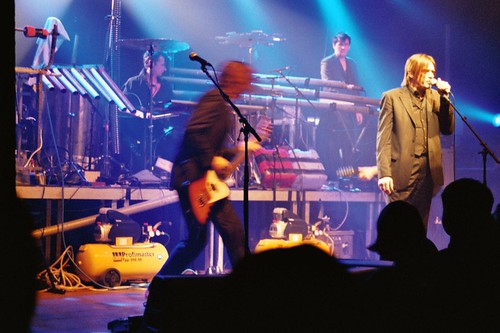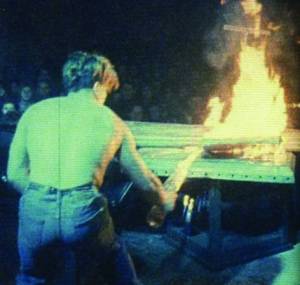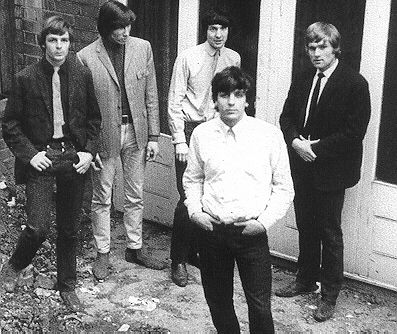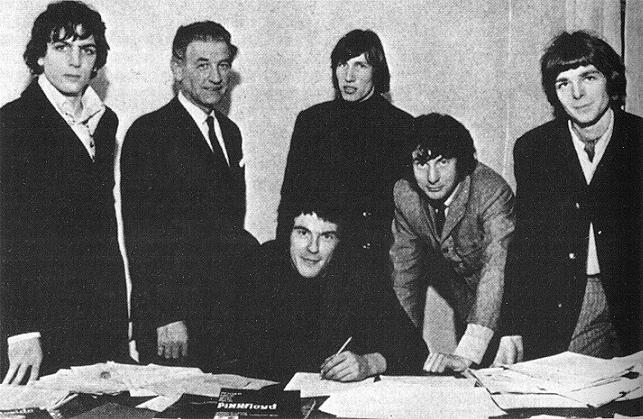 1980 (The Beginning)
1980 (The Beginning)
Einstürzende Neubauten was formed 1980 in Berlin as a part of the Die
Geniale Dilletanten, a dadaistic musical movement that had as a common
goal to break down all musical conventions. Einstürzende also gained
recognition because of their use of metal plates, electric drills,
metal cutters and circle saws as instruments.
On April 1, 1980, Einstürzende Neubauten made their first appearance in
the Moon Club in Berlin. The first setup contained Blixa Bargeld
(Christian Emmerich, born 12 jan 1959, Berlin), N.U. Unruh (Andrew
Chudy, born in New York 9 jun 1957), Beate Bartel and Gudrun Gut
The two female members, Bartel and Gut,had been active through the punk
wave and left the band after a short period of performing and founded
Mania D.
Einstürzende Neubauten (translated "collapsing" or "imploding new
buildings") didn´t do any over night success, but they were talked of.
When the new built German Congress Center collapsed just a few days
before the opening ceremony and just a few days after the release of
their first single, the talk got a new dimension.
Einstürzende Neubauten's logo (a symbol of human with a circle in the head) is an ancient Toltec cave drawing.
Musically they have created a new form of "urban story blues" with a
very physically intensive and organic sound, much due to their habit to
record the source instead of sample and process sounds digitally. The
lyrics are often centered on themes like modern foundering and extreme
psychologic states such as love or depression.
Stahlmusik was recorded live to tape in a pillar of the Stadtautobahn
Bridge in West Berlin on June 1, 1980, and was released on cassette in
October via Blixa Bargeld's "Eisengrau" shop, where the earliest
incarnations of the band would often rehearse. Musically, the sound of
the album is more conventional than the band's next "album", Kollaps,
mainly because percussionist N.U. Unruh had not yet abandoned his
drum-kit for the miscellaneous scrap metal of later releases
1981-1982

In 1981 the percussionist F.M. Einheit (Frank Martin Strauss, born 18
Dec 1958 in Dortmund) were persuaded by Blixa and N.U. to join
Einstürzende Neubauten after an Abwärts concert on a tavern next to the
former concentration camp Dachau.
F.M. had formed the punk group Abwärts (roughly translated "Downwards")
in Hamburg a few years earlier, in which he played everything that gave
noice (tapes, radios etc). As F.M is something of an electronic and
musical genius with an history through, among others, Palais
Schaumburg, a legendary avant-garde group found by Holger Hiller in
1980, he broadened the sound and the possibility's of the group as he
joined.
They released their first LP Kollaps 1981 (English: "Collapse"), a
mixture of rough punk rock tunes and industrial noises. The industrial
noises were obtained from self-made music machines, electronics, and
found objects such as metal plates. The live performances with FM
Einheit in the 1980s, which became legendary, included lots of metal
banging and destruction on stage

With this setting they recorded their first LP "Kollaps". On their
first German tour together with Mekanik Destruktiw Kommandöh and Sprung
Aus Den Wolken, Marc Chung (born in Leeds 3 jun 1957), the bass player
of Abwärts joined the group.
Alexander von Borsig (Alexander Hacke, Berlin 11 oct 1965) joined the
group in 1982. He was at the time only 16 years old, but had been sound
technician to Einstürzende for some time as well as a good friend
1983-1984
In 1983, Einstürzende Neubauten recorded their second album Zeichnungen
des Patienten O. T. (English: "Drawings of Patient O.T."). The title
came from a 1974 book by Leo Navratil, describing the drawings of
Oswald Tschirtner an international breakthrough among the critics.
They also created quite some fuzz with a line of spectacular ("terroristic and death-despising") concerts.
Also in 1983, Bargeld joined the band The Birthday Party (featuring
Nick Cave and Mick Harvey) as a guitarist. The group was disbanded
shortly after, but Bargeld became a long-time member of one of the
bands that sprang from The Birthday Party - Nick Cave and the Bad Seeds
(again featuring Nick Cave and Mick Harvey).
Bargeld remained a full-time member of two bands, Einstürzende
Neubauten and Nick Cave and the Bad Seeds, until 2003, when he quit the
Bad Seeds in order to focus on Einstürzende Neubauten.
With the following album, "1/2 Mensch" they got their great
breakthrough (though not commercially). It was the first of their
albums that had a clear musical structure. Blixa´s lyrics had also
become clearer and more precise. On the title track they worked
together with Nikkolai Weidemann to compose a choral work. Their
concerts also became less like riots.
1985-1989

The band's next album, Halber Mensch ("Half Man") in 1985, may be seen
as a developmental breakthrough. Musical structure became more evident,
and Bargeld's lyrics and, especially, his singing changed. He moved
from shouted words and phrases toward organized, poetic melodies.
The band played a show in Vancouver, British Columbia, Canada, to kick
off their third North American tour. The performance was sponsored by
the German Goethe Institute as part of the German contribution to Expo
86. Also scheduled to appear were Test Dept and Skinny Puppy, though
not everyone was able to play.
On the tour, the group's experimental and improvised live performance
style occasionally caused difficulties with venue management and law
enforcement. A performance at The Palladium in Manhattan ended 30
minutes into the set after an improvised pyrotechnics display. The band
ignited a small amount of paint thinner in metal pans, and panicked
management stopped the performance and cleared the venue.
The one-hour film Halber Mensch (1986) by Sōgo Ishii documents Einstürzende Neubauten's visit to Japan in 1985.
Fourth Album Fünf auf der nach oben offenen Richterskala ("Five on the
open-ended Richterscale") in 1987 showed yet another side of the group.
More worked-through and constructed than ever, consisting of
atmospheric songs with far more instrumental shiftings than before.
Some critics saw this as Blixa had drawn a bit of The Bad Seeds into
the Neubauten.
Fünf auf der nach oben offenen Richterskala was a success in both the United States and Japan.
Although, Blixa is not the only one engaged in another group beside
Einstürzende Neubauten. In fact, N.U. Unruh is the only member who is
not.
F.M. Einheit have played with a lot of more or less permanent settings
among the years, producing records for among others KMFDM, Die Krupps
and PIG (ex KMFDM). He also restarted Abwärts in 1988, where he is a
full time member and started doing recordings in his own name at the
same time. He also has his solo project Stein together with Ulrike
Haage and have recently recorded with Caspar Brötzmann.
Alexander Hacke joined Crime and the City Solution when Rowland S.
Howard left that group in 1988 (as Birthday Party split in 1983, the
group became two; Nick Cave and the Bad Seeds and Crime and the City
Solution. Both groups have common members and were at times accused to
sound the same way. They are both signed to Mute records and are
oftened named in the same breath). Alex has also acted as a producer
and a session musician in different constellations.
Marc Chung formed Freibank, the Einstürzende Neubauten publishing
company when background tapes and sound from their records started to
appear frequently on other artist´s records. He also hands the economic
aspects of the group.
N.U. Unruh are though engaged in a loose collaboration with the
Survival Research Laboratory, an American performance group that build
mighty bizarre machinery and blow them up in spectacular ways during
their performances.
In 1987 Einsürzende Neubauten performed the music for the theatre play "Andi" on Deutches Schauspielhaus in Hamburg.
This was an excellent opportunity for the German scandal press to
introduce Einstürzende Neubauten to a broader public, as they did.
Earplugs were given to the theatre public.
Though this, after the premiere, Einstürzende had to give encores. This
was a new step for Einstürzende, into the "fine", established culture.
They have since written music for a handful of radio-theater and theater plays, ballets and dance academies (not always without
confrontations, as the group often is considered as sensationalistic
amateurs by the more established cultural society). Mufti is the
Neubauten-member most engaged in theater.
In 1989 the fifth album Haus der Lüge ("House of the Lie") was also a success in the United States and Japan.
It marked a new point of direction, already hinted with Fünf auf
nach..., but never clearly stated. With stricter rhythmic, even clearer
musical directories and more political lyrics it gave a sharper profile
for the group and made them more accessible to a wider public.
This strength was further manifested on a following world tour.
1990-1995

In 1990 Einstürzende Neubauten signed with the record company Mute. The
sublabel EGO was formed 1991. This sublabel only releases different
side projects by Einstürzende and its members.
The first release on this sublabel were in 1991, the band tried
something completely new, recording the soundtrack for East German
playwright Heiner Müller's play Die Hamletmaschine ("The Hamlet
Machine") for East German radio Rundfunk der DDR. where Blixa perform
Hamlet and Neubauten present the soundtrack
The band image of Einstürzende Neubauten changed: Blixa Bargeld,
formerly wearing punk/industrial style clothes, appeared at the live
concerts in a suit.
1991 also saw the release of the double album, a best-of and rarities
album, Strategies Against Architecture II. This collection included a
musical setting of Heiner Müller's piece "Bildbeschreibung" ("Explosion
of a Memory" or "Description of a Picture" in English).
In Vienna, May 1992, Einstürzende Neubauten performed at The Academy of
Fine Arts' 300th anniversary in a show by Erich Wonder, Das Auge des
Taifun ("The eye of the typhoon").
The next album Tabula Rasa (1993) was an important turning point in the
band's history, their music becoming softer and containing more
electronic sounds. Martin Munsch, a Factory QC mastering engineer for
the album's final mass duplication in New Jersey, commented on the
production as being one of their most insidious to date.
Tabula Rasa was the first album where Einstürzende Neubauten performed
any songs on another language than German. The album was a very well
produced further development of the former "Haus der Lüge". They also
presented some of their works for the "LaLaLa" dance academie.
Mark Chung left the band in 1994 after recording Faustmusik, and made a
career in the music industry. F.M. Einheit, who contributed much to the
music and sound of the band, left the band a short time later in 1995,
during the recording of the Ende Neu album, at least partially because
of a conflict with Bargeld. The last Einstürzende Neubauten track
Einheit worked on was "Was ist ist". Roland Wolf replaced them on bass
guitar and keyboards only a short time before tragically dying in a car
accident in 1995.
1996-1999
A short time later, the band released the album Ende Neu ("Ending New")
in 1996. The album title is an example of word-play on the band's own
name (i.e. "Einstürzende Neubauten"). Every trace of the early days
nihilistic Einstürzende are refreshed to a living Neubauten. This
development has taken place without any loss of strength or
originality. "Stella Maris", a duet with Blixa and Meret Becker Hacke's
then-wife, is one of the most lyrical moments ever produced by the
group.
 An Instrument!
http://www.neubauten.org/en-photos-instr.html
An Instrument!
http://www.neubauten.org/en-photos-instr.html
Singer Meret Becker - became quite famous; a world tour followed the
release. During this time, Jochen Arbeit and Rudi Moser (both members
of Die Haut) joined the band: Arbeit on guitar, and Moser on drums,
with Hacke switching to bass guitar. This line-up, accompanied by Ash
Wednesday on keyboards for live concerts, has held ever since.
In 1997, the album Ende Neu Remixes was released, which featured
remixes of the songs from Ende Neu by artists such as Barry Adamson and
Pan Sonic.
2000-2001

Live at "Tollhaus" in Karlsruhe, May 2000: Alexander Hacke (left) and Blixa Bargeld (right)
From March 27 to May 23, 2000, Einstürzende Neubauten celebrated their
20th birthday with a "20th anniversary tour", playing in the
Columbiahalle, Berlin on their exact birthday, April 1, and released
the album Silence Is Sexy, followed by a world tour. 2001 also saw the
release of another double best-of and rarities album, Strategies
Against Architecture III.
Since 2001, Einstürzende Neubauten albums and web projects have been
partially produced and supported by Bargeld's wife Erin Zhu, who also
serves as webmaster of the official Einstürzende Neubauten website.
2002-2004

In 2002, Einstürzende Neubauten began work on a new album without the
backing of a record label, relying instead upon fan ("supporter")
participation in an experiment of a type of Street Performer Protocol
combined with an internet community and touches of the patronage
system. An exclusive Supporter Album No. 1, and the Airplane Miniatures
EP following, were made available in 2003.
Bargeld left Nick Cave and the Bad Seeds in 2003. In order to go on
tour, the band reneged on the idea of creating a supporter-only album,
and cooperated with Mute Records to go on tour and release Perpetuum
Mobile in 2004. Air sounds, such as blowing the plastic pipes with an
air compressor, were greatly explored and used for this album: the
working title of the album was, for a long while, Luftveränderung
("Change of air").
The live shows of the Perpetuum Mobile Tour were recorded by the band's
sound engineers, then burned on CDRs with individual pictures of each
show taken by Danielle de Picciotto and sold directly after the
concerts to the visitors; numerous "official" live albums were created
during this tour as a result. Unfortunately, these live albums include
some cuts and errors.
In November 2004, the band went on a mini-tour, which included a
supporters-only performance at Berlin's Palast der Republik. The
performance was filmed and coordinated by Danielle de Picciotto and Ian
Williamson and was released on the exclusive supporter's DVD at the end
of Phase II.
2005

The band also started a new project called Musterhaus in early 2005.
The first CD Anarchitektur was sent out in May 2005, and was also
available for download to Musterhaus subscribers. The Musterhaus
project was a "line of releases intended to give the band an outlet for
more experimental impulses and exploration." Musterhaus albums were
released roughly every 3 months.
The second Musterhaus CD Unglaublicher Laerm ("Incredible noise") was
finished on August 15, and shipped out (as well as posted for download)
shortly after.
Phase II of the Neubauten Supporter's project finished in August 2005,
and the official site was taken down on September 20. The supporter
album Grundstück ("Floor-piece") and DVD (containing footage from the
November 2004 Grundstück performance in Berlin) was shipped in early
October 2005.
Musterhaus #3 Solo Bassfeder ("Solo bass-spring"), released December 8,
is a collection of bass spring compositions by the individual members
of Einstürzende Neubauten.
2006

Phase III of the Supporter's project started on February 10. On
February 25, the fourth part of the Musterhaus series, called Redux
Orchestra versus Einstürzende Neubauten was completed. One of the new
additions to Phase III started in March 2006 was a piece-by-piece album
called Jewels, finally finished in August 2007.
Danielle de PicciottoAlexander Hacke´s wife and long time companion
releases the DVD documentary "Einstürzende Neubauten - On tour with
neubauten.org" which describes the supporter project in detail ,having
interviewed international supporters during the Perpetuum Mobile tour
in 2004.
Musterhaus #5 Kassetten ("Cassettes"), finished May 15 with release
scheduled for May 31. At the same time, Alles was irgendwie nützt
("Everything of any use"), an album that had been in the work since
Phase 2, were completed. The album consists of rare live tracks,
handpicked by 6 supporters of Phase 2 and mixed by Boris Wilsdorf. This
was quickly followed by Musterhaus #6 Klaviermusik ("Piano music"),
released on August 31.
In October, Neubauten released a public DVD, the recording made at Palast der Republik.
Musterhaus #7 Stimmen Reste ("Voice Remainders") was released on
December 2, consisting of vocal experiments, vocal recordings, and
manipulations of voice recordings, enriched with leftover instrumental
tracks made with polystyrene, electronic pulses, hammond organ, bass
guitar, and metal percussion.
2007-2008

It was announced on the band's website that they would be undertaking a
"small (mostly) UK tour" in April 2007, playing in Hannover on April 22
beforehand. Musterhaus #8 Weingeister ("Wine spirits") was released on
April 6, forming the final installment of the Musterhaus series. The
band also filmed a video for "Nagorny Karabach".
A new commercial album was made available later in the year, the first
release since 2004's Perpetuum Mobile. The new album, Alles wieder
offen ("All open again"), was released on October 19, 2007 without the
backing of a label, a move the band had intended to make with Perpetuum
Mobile. Fans who were part of the paid EN community at neubauten.org
received access to an album with the same tracks plus a number of extra
songs, and an optional DVD about the making of the album.
The band spent the first half of 2008 touring for their new album, and played 32 dates in 19 European countries.
Facts and Rumors
# Blixa Bargeld has worked as a grave digger and as a garbage man, two
very well payed jobs in Berlin. He also owned a little store for
cassettes and second hand things called Eisengrau.
# For a short period Blixa sung in a punk band before Einstürzende. He
mentions this as "just a bunch of kids that wanted me to sing because
the way I looked. The only thing which came out of this was that I
started singing".
# The primitive man with a sunwheel head that has been Einstürzendes
symbol and logotype since the first LP is said to be found at
Stonehenge. Other, maybe more reliable, sources say that the band made
up this logo themselves.
# The first place they used for rehearsals was a small room within a
highway bridge in the outcasts of West-Berlin. Its location was kept as
a secret and friends coming to visit were blindfolded. Within the room
a candle was always lit to indicate the amount of oxyge.
# Einstürzende´s main inspiration is music they don´t like. When
exposed, they listen carefully, analyzes, deconstruct...and react.
# The back cover shot on the first album is a parody on the back cover
shot on Pink Floyd´s classical "Umma Gumma"- double album.
# On an early concert in Oslo, Norway, they left the stage by drilling a hole in the wall, through which they escaped.
# After their first German tour in 1981, they refused to play in Western Germany until 1985.
# Nick Cave and The Birthday Party saw a short piece of an Einstürznde
show in Dutch television as they toured Holland. They were impressed
and became friends with EN. Shortly thereafter they abandoned London
and moved to Berlin.
# Other groups have followed the trail where Neubauten were stalkers.
Australian SPK renewed their sound and incooperated a big portion of
metal junk, Foetus added portions of tortured metal into his songs and
British Test Dept. started their career 1981 with metal-only
instrumentation. Although none of these groups had the same chaotic and
anarchistic attitude towards their deed as their gurus.
# The Halber Mensch-tour were the first tour when they left the
pneumatic drills at home. They started the set with "Zerstörte Zelle"
# In USA they made a performance together with the Survival Research Laboratorys in the Mojave desert.
# "How Long" (re-titled "Subterranean World") also appears on Anita
Lane's album "Dirty Pearl" in 1993. This release also features EN
involvement on the tracks "Blume" (as taken from EN's "Tabula Rasa"),
"Picture of Mary" (with Bargeld playing guitar), "Stories of Your
Dreams" (guitars by Alex Hacke), and "A Prison In The Desert". This
last track is taken from the soundtrack to "Ghost...of the civil dead".
# Performing live in Göteborg, Sweden, they threw molotov cocktails at the public.
# The "Concerto for Voices and Machinery" were performed at the
Institution of Contemporary Art in London early 1984. On this legendary
occasion Einstürzende Neubauten (without Blixa) were aided by Stevø of
Some Bizzare, Frank Tovey (a.k.a. Fad Gadget) and Genesis P-Orridge.
The aim was to incoorperate the sounds performed by the performers into
an orchestral arrangement. The instrumentation were made up by concrete
mixers, electric saws, acetylene torhes and generators.
Something went wrong and a large piece of the stage were destroyed and
the ICA staff forced the concerto to a quick end, but 30 or so hardcore
fans refused to leave the hall. The performers later told: "After the
breakdown, we decided to try and get below the stage. We´d heard that
there were tunnels from (nearby subway station) Whitehall and the
Palace running underneath the stage and had half the aim of getting to
them. But the stage was reinforced. We decided to stop when it looked
like someone might get hurt."
http://neubauten.synth.no/index.html
http://en.wikipedia.org/wiki/Einst%C...ende_Neubauten


































